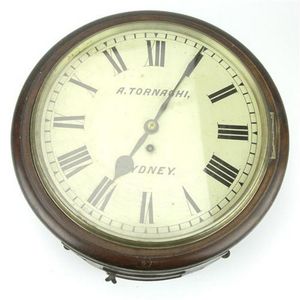Miniature George III Verge Wall Clock by Daniel Gill
You must be a subscriber, and be logged in to view price and dealer details.
Subscribe Now to view actual auction price for this item
When you subscribe, you have the option of setting the currency in which to display prices to $Au, $US, $NZ or Stg.
- Pendulum - The pendulum was discovered around 1602 by Galileo Galilei, and was adopted for time keeping by the Dutch mathematician and natural philosopher, Christiaan Huygens, who excelled in astronomy, physics, and horology.
The pendulum comprises a metal rod usually of brass or steel with a metal disk, known as a bob, at the end. The movement of the pendulum is driven by weights or a spring, and as a pendulum swings in a regular arc, it was found accuracy could be controlled to within a few seconds a week.
Timekeeping can be adjusted by changing the height of the bob on the rod, making the pendulum either swing slower or faster.
The disadvantage of the pendulum was that changes in temperature also changed the length of the pendulum, interfering with the accuracy of the clock, and so in the 18th century two types of mercurial pendulums were invented which countered the movement in the steel rod.
The pendulum was the world's most accurate timekeeping technology until the invention of the quartz clock, regulated by a quartz crystal, in 1927. - Bob Pendulum - A bob pendulum consists of a brass or steel rod with a disc shaped metal weight at the end. The most common use of a bob pendulum is in a grandfather clock where it oscillates to keep the time. The length of the rod and the weight of the bob are the key parameters for determining the period of oscillation, and the timekeeping of the clock can be accelerated or slowed by altering the height of the bob.
- Movement - The technical name for the workings of a clock or watch, and does not include the dial or case.
- George Iii - George III (1738 - 1820) was King of Great Britain and Ireland from 1760 to 1820.
- Fusee - The fusee movement was used in clocks and pocket watches from the mid 17th century. The fusee is a cone shaped drum within the works that is linked to the barrel of the spring, usually by a length of chain.
As the mainspring loses its tension over time, the cone shaped barrel compensates for this by increasing the tension, by pulling the mainspring tighter, thus ensuring the time remains constant.
Use of the fusee in clocks was superseded by the "going barrel" in the mid 19th century and for pocket watches at the beginning of the 19th century.
The fusee continued to be used in marine chronometers until the 1970s. - Verge Escapement - A verge escapement is an early mechanical escapement used in clocks and other timekeeping devices. It is an early form of the escapement mechanism, which is used to regulate the movement of the hands of a clock or watch. The verge escapement consists of a vertical shaft called the verge, which is mounted on the clock's main plate. Attached to the verge are two pallets, which engage with the teeth of the escape wheel. As the escape wheel turns, the pallets alternately lock and release it, allowing the movement of the clock to be regulated. The verge escapement was widely used in early mechanical clocks, but it was eventually replaced by the more accurate and reliable anchor escapement.
This item has been included into following indexes:
Visually similar items

A Georgian silver pocket watch. Sterling silver, Georgian, inner case and outer case dated 1808 Thomas Barker, David. (1941 - the pocket marked William blackwood N.B. Shields (1820-1827) no 95, verge fusee movement, with inner papers.

Pair of electric railway clocks, each 46 cm diameter

Eberhard & Co., gold plated silver gents wristwatch, limited antique edition, 92/499, c. 1940, automatic movement, gold plated sterling silver case and movement, enamel white dial with Arabic numerals and baton indexes, aperture for date and moon phase cal

Angelo Tornaghi wall clock from Typewriter Repair branch having a white enamelled dial with Roman numerals, with a bevelled glass front, with papers stating 'O.H.M.S. From Government Stores Department, Lands Dept, Bridge Street, Sydney'. Condition good ove
